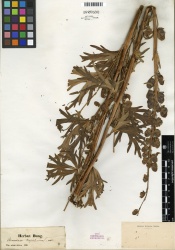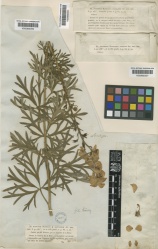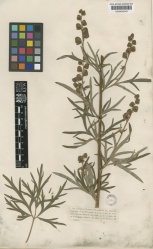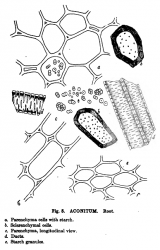| "Aconitum Napellus is a perennial herbaceous plant, with a conical- shaped, tapering root, seldom exceeding 10 cm. in length and 2 cm. in thickness near the summit, brownish externally, whitish and fleshy within, and sending forth numerous long, thick, fleshy rootlets. When the plant is in full growth, there are usually two roots joined together, of which the older is dark brown and supports the stem, while the younger is of a light yellowish-brown, and is destined to furnish the stem of the following year, the old root decaying.
"The stem is erect, round, smooth, leafy, usually simple, and from two to six or even eight feet high. The leaves are alternate, petiolate, divided almost to the base, from two to four inches in diameter, deep green upon their upper surface, light green beneath, somewhat rigid, and more or less smooth and shining on both sides. Those on the lower part of the stem have long footstalks and five or seven divisions; the upper, short footstalks and three or five divisions. The divisions are wedge-form, with two or three lobes, which extend nearly or quite to the middle. The lobes are cleft or toothed, and the lacinise or teeth are linear or linear-lanceolate and pointed. The flowers are of a dark violet-blue color, large and beautiful, and are borne at the summit of the stem upon a thick, simple, straight, erect, spike-like raceme, beneath which, in the cultivated plant, several smaller racemes arise from the axils of the upper leaves. Though without calyx, they have two small calycinal stipules, situated on the peduncle within a few millimeters of the flower. The petals are five, the upper helmet-shaped and beaked, nearly hemispherical, open or closed, the two lateral roundish and internally hairy, the two lower oblong-oval. They enclose two pediceled nectaries, of which the spur is capitate, and the lip bifid and revolute. The fruit consists of three, four, or five follicles. The seeds are wrinkled or scaly ..."
Source: United States Dispensatory (1918) [6]
|
|
|





